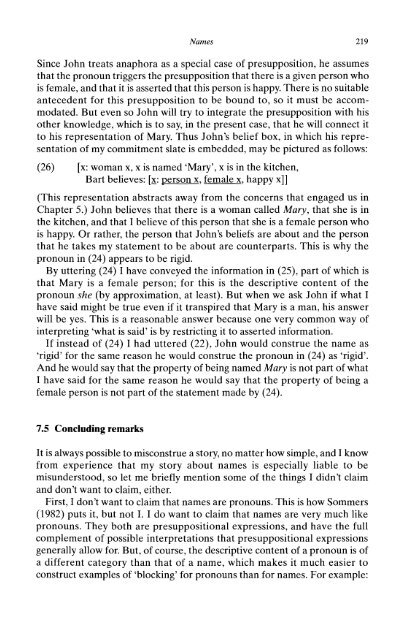Presuppositions and Pronouns - Nijmegen Centre for Semantics
Presuppositions and Pronouns - Nijmegen Centre for Semantics
Presuppositions and Pronouns - Nijmegen Centre for Semantics
You also want an ePaper? Increase the reach of your titles
YUMPU automatically turns print PDFs into web optimized ePapers that Google loves.
Names 219<br />
Since John treats anaphora as a special case of presupposition, he assumes<br />
that the pronoun triggers the presupposition that there is a given person who<br />
is female, <strong>and</strong> that it is asserted that this person is happy. There is no suitable<br />
antecedent <strong>for</strong> this presupposition to be bound to, so it must be accom-<br />
accommodated.<br />
But even so John will try to integrate the presupposition with his<br />
other knowledge, which is to say, in the present case, that he will connect it<br />
to his representation of Mary. Thus John's belief box, in which his representation<br />
of my commitment slate is embedded, may be pictured as follows:<br />
(26) [x: woman x, x is named 'Mary', x is in the kitchen,<br />
repre-<br />
Bart believes: [x: person x, female x, happy x]]<br />
(This representation abstracts away from the concerns that engaged us in<br />
Chapter 5.) John believes that there is a woman called Mary, that she is in<br />
the kitchen, <strong>and</strong> that I believe of this person that she is a female person who<br />
is happy. Or rather, the person that John's beliefs are about <strong>and</strong> the person<br />
that he takes my statement to be about are counterparts. This is why the<br />
pronoun in (24) appears to be rigid.<br />
By uttering (24) I have conveyed the in<strong>for</strong>mation in (25), part of which is<br />
that Mary is a female person; <strong>for</strong> this is the descriptive content of the<br />
pronoun she (by approximation, at least). But when we ask John if what I<br />
have said might be true even if it transpired that Mary is a man, his answer<br />
will be yes. This is a reasonable answer because one very common way of<br />
interpreting 'what is said' is by restricting it to asserted in<strong>for</strong>mation.<br />
If instead of (24) I had uttered (22), John would construe the name as<br />
'rigid' <strong>for</strong> the same reason he would construe the pronoun in (24) as 'rigid'.<br />
And he would say that the property of being named Mary is not part of what<br />
I have said <strong>for</strong> the same reason he would say that the property of being a<br />
female person is not part of the statement made by (24).<br />
7.5 Concluding remarks<br />
It is always possible to misconstrue a story, no matter how simple, <strong>and</strong> I know<br />
from experience that my story about names is especially liable to be<br />
misunderstood, so let me briefly mention some of the things I didn't claim<br />
<strong>and</strong> don't want to claim, either.<br />
First, I don't want to claim that names are pronouns. This is how Sommers<br />
(1982) puts it, but not I. I do want to claim that names are very much like<br />
pronouns. They both are presuppositional expressions, <strong>and</strong> have the full<br />
complement of possible interpretations that presuppositional expressions<br />
generally allow <strong>for</strong>. But, of course, the descriptive content of a pronoun is of<br />
a different category than that of a name, which makes it much easier to<br />
construct examples of 'blocking' <strong>for</strong> pronouns than <strong>for</strong> names. For example:














